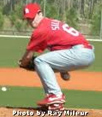Mike Sillman, Former AAA St. Louis Cardinals
1. Could you tell us your story on dropping down?
I was straight over the top my entire life all the way through my junior fall at the University of Nebraska-Lincoln. While I was at Nebraska, I had a lot of ups and downs. I struggled with any consistency in my breaking ball and I wasn't a reliable option. My pitching coach at the time (Rob Childress-now the head coach at Texas A&M) called me into his office and asked if I would try dropping my arm angle down. I told him I would try anything if he thought it would be for the best of me and the team. We experimented with different arm angles for the entire winter. I started out with a very low submarine delivery. I was extremely wild with that angle and slowly brought my arm angle higher. Eventually, I ended up throwing sidearm.
2. What are some of the advantages you had from your arm angle?
The biggest advantage of throwing sidearm comes from the unorthodox delivery. Hitters are trained their entire lives to focus on roughly the same release point. While you lose some velocity throwing sidearm, it does bring a natural deception. As I gained experience with the arm angle, I was able to start focusing on my finger location on each pitch's release. When my fingers were on the side of the ball on fastballs, I would get more lateral movement. When my fingers where able to get on top of the ball and naturally roll over upon release, I would get much more depth on my fastball. This is where I had most of my success.
3. If you didn't drop down, do you think you would have had the same success?
I know I would not have had near the success I experienced without changing my arm angle.
4. What would you tell someone debating on changing their arm angle?
I would definitely stick with not throwing sidearm for as long as you can...especially if you're right handed. Once you make the decision to throw sidearm you must accept that if you are looking at ever being a professional baseball player, you are 99% of the time going to be a reliever. Since relievers are 'a dime a dozen' you will not be valued very highly. You will be looked upon as more of a 'gimmick' pitcher and you're road to the big leagues will be a tough one.
If you're just looking to change to sidearm for your high school or college team, I would still very heavily consider not doing it. If you believe that it is the only way you will experience success then go ahead and make the change. Just realize that it will take a lot of work and you will not be given the same look from college coaches and professional scouts.
5. Are there any mechanical tips that you'd give to someone throwing sidearm/submarine?
I had a few keys I focused on during my delivery. First, I wanted to begin my delivery by staying low. This entails making sure that my chest stays somewhat parallel to the ground. If my chest was more perpendicular to the ground and I was standing straight up, my fingers never had a chance to get to the afforementioned top of the ball. When my chest stayed up then my fingers would stay on the side of the baseball. Again, this would cause my ball to move laterally with little depth. When my ball lacked depth and stayed on one plane, I never had much professional success.
After I focused on beginning my delivery by getting my chest more parallel to the ground, I shifted my focus to keeping my upper body from standing straight up. Again, if I started my chest down and popped up I would struggle with getting my fingers in the correct position.
6. What pitches did you throw?
I threw 3 pitches...a 2 seam fastball, a changeup and a slider.
7. How did you pitch to lefties/righties?
Being a right handed sidearm picher, I loved pitching to right handed hitters. I would challenge them early. In a situation where I didn't need a strikeout, I would throw my 2 seam fastball right down the middle. I let the run/sink take the ball to the inner-third of the plate. If they wanted to swing, I was more than happy to let them pound the ball into the ground. If they fouled it off or took it for a strike, I would sit middle/away with my slider. My slider was by far my best pitch so I would go to it early and often. In a 0-2 or 1-2 count, I would start getting to the outer black or just off the plate. In a 2-2 or 3-2 count, I would again go back to the middle of the plate.
Against a left handed hitter, I would again attack early with a fastball down the middle. I would also use my changeup middle/middle away. When I noticed the hitter start leaning over the plate, I would throw my slider inside to keep them honest.
8. Lastly what was your favorite part about pitching from down there?
sidearm was the body language of some of the right handed hitters. You could tell when a batter stepped in the box if he was already mentally beat.





